Australian Engineering Practice: Learning Outcomes Reflection
VerifiedAdded on 2021/06/14
|6
|1529
|17
Homework Assignment
AI Summary
This assignment reflects on two key learning outcomes in Australian Engineering Practice: leading or participating collaboratively in teams and demonstrating critical self-review, self-management, and lifelong learning. The assignment defines team collaboration, emphasizing its effectiveness and the development of responsibility among team members. It highlights the importance of shared goals and the promotion of self-analysis within teams, as well as the competencies required for effective team leadership, including promoting understanding, providing relevant information, and facilitating effective interaction. The assignment also defines critical self-review, self-management, and lifelong learning. It discusses the significance of self-review in fostering communication, encouraging growth, and promoting accountability. It identifies key self-management skills and explores methods for enhancing these skills, such as understanding organizational success factors and setting long-term goals. Furthermore, the assignment emphasizes the benefits of lifelong learning in boosting self-esteem, adaptability, and knowledge, offering insights for personal and professional development. The assignment is supported by references to academic sources.
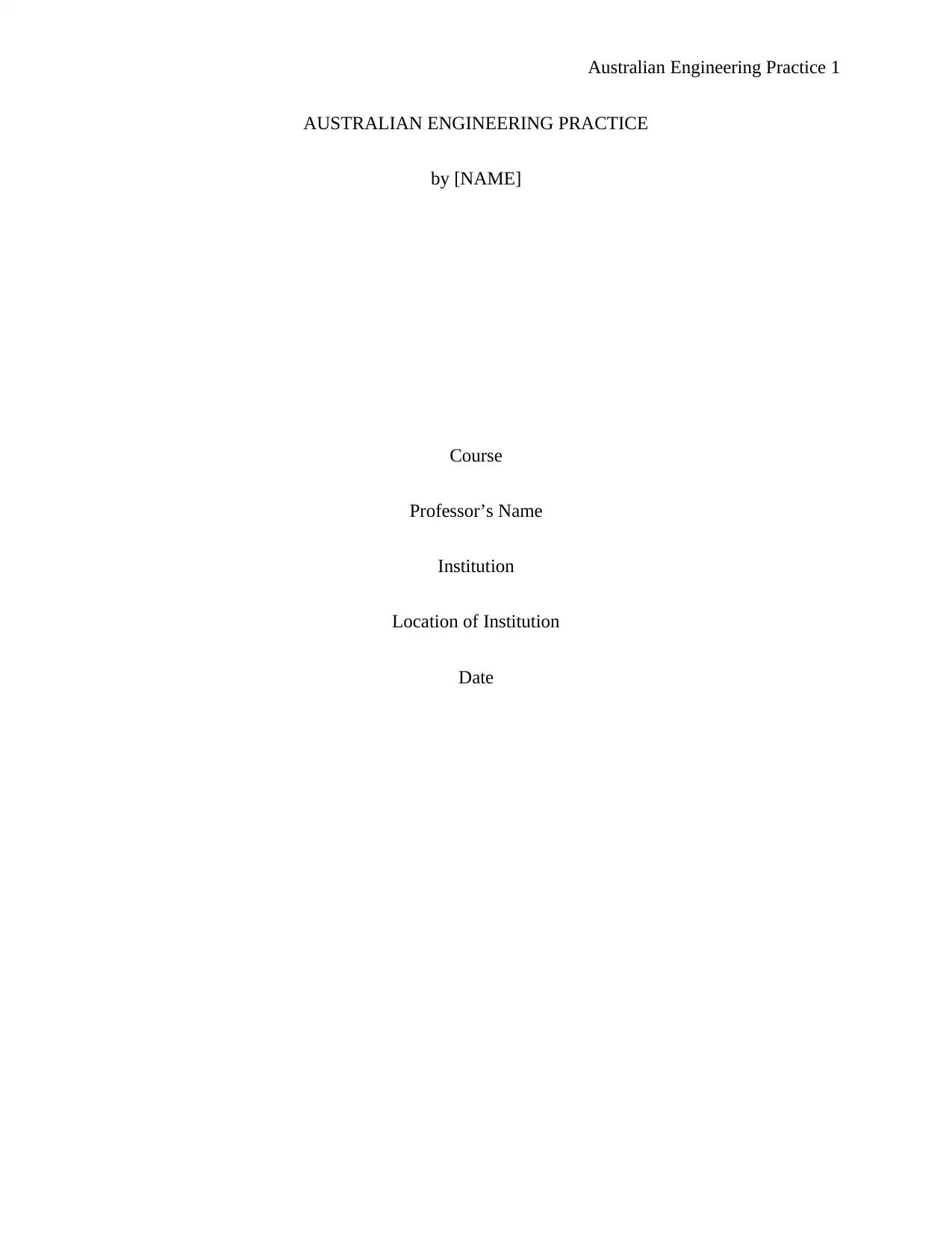
Australian Engineering Practice 1
AUSTRALIAN ENGINEERING PRACTICE
by [NAME]
Course
Professor’s Name
Institution
Location of Institution
Date
AUSTRALIAN ENGINEERING PRACTICE
by [NAME]
Course
Professor’s Name
Institution
Location of Institution
Date
Paraphrase This Document
Need a fresh take? Get an instant paraphrase of this document with our AI Paraphraser
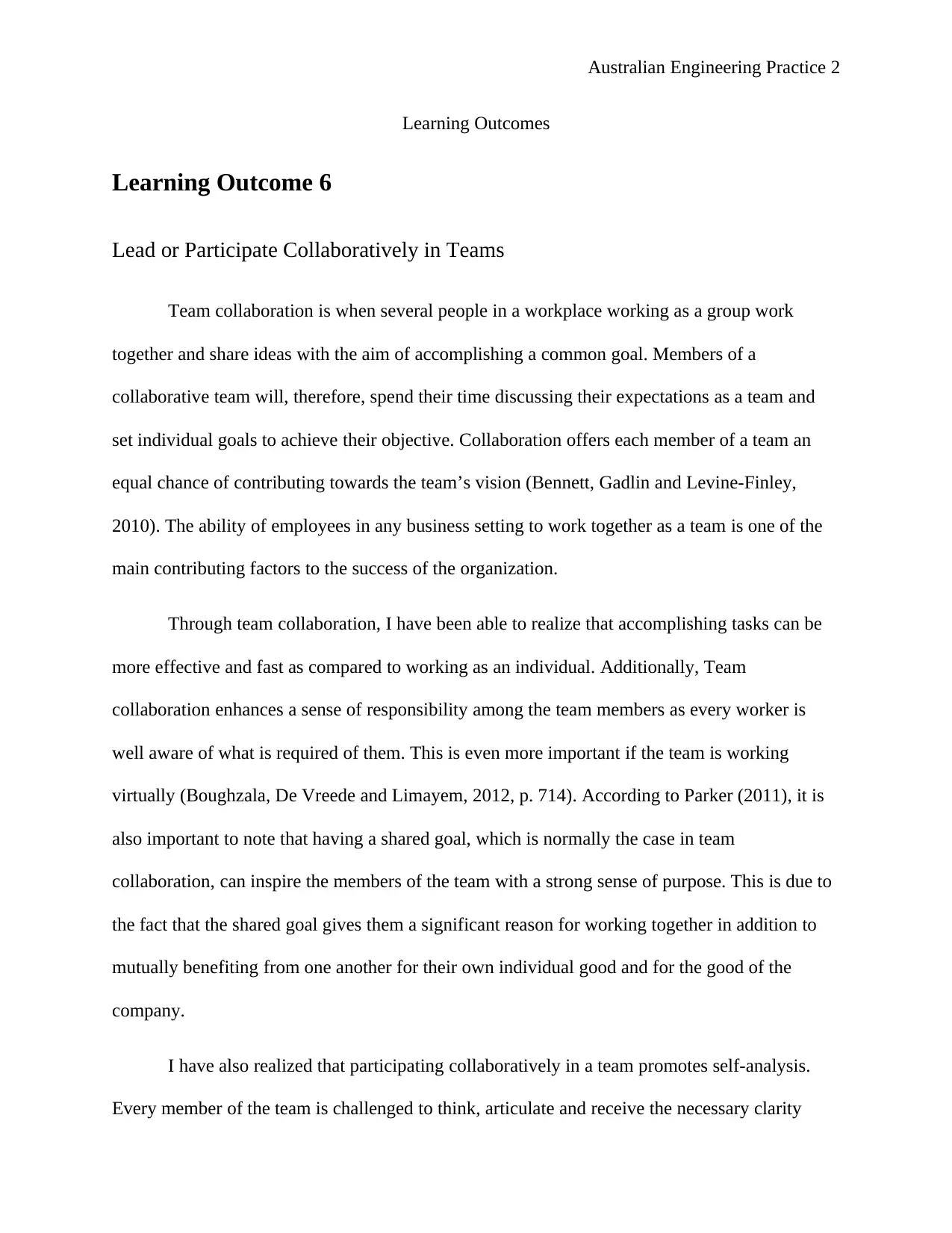
Australian Engineering Practice 2
Learning Outcomes
Learning Outcome 6
Lead or Participate Collaboratively in Teams
Team collaboration is when several people in a workplace working as a group work
together and share ideas with the aim of accomplishing a common goal. Members of a
collaborative team will, therefore, spend their time discussing their expectations as a team and
set individual goals to achieve their objective. Collaboration offers each member of a team an
equal chance of contributing towards the team’s vision (Bennett, Gadlin and Levine-Finley,
2010). The ability of employees in any business setting to work together as a team is one of the
main contributing factors to the success of the organization.
Through team collaboration, I have been able to realize that accomplishing tasks can be
more effective and fast as compared to working as an individual. Additionally, Team
collaboration enhances a sense of responsibility among the team members as every worker is
well aware of what is required of them. This is even more important if the team is working
virtually (Boughzala, De Vreede and Limayem, 2012, p. 714). According to Parker (2011), it is
also important to note that having a shared goal, which is normally the case in team
collaboration, can inspire the members of the team with a strong sense of purpose. This is due to
the fact that the shared goal gives them a significant reason for working together in addition to
mutually benefiting from one another for their own individual good and for the good of the
company.
I have also realized that participating collaboratively in a team promotes self-analysis.
Every member of the team is challenged to think, articulate and receive the necessary clarity
Learning Outcomes
Learning Outcome 6
Lead or Participate Collaboratively in Teams
Team collaboration is when several people in a workplace working as a group work
together and share ideas with the aim of accomplishing a common goal. Members of a
collaborative team will, therefore, spend their time discussing their expectations as a team and
set individual goals to achieve their objective. Collaboration offers each member of a team an
equal chance of contributing towards the team’s vision (Bennett, Gadlin and Levine-Finley,
2010). The ability of employees in any business setting to work together as a team is one of the
main contributing factors to the success of the organization.
Through team collaboration, I have been able to realize that accomplishing tasks can be
more effective and fast as compared to working as an individual. Additionally, Team
collaboration enhances a sense of responsibility among the team members as every worker is
well aware of what is required of them. This is even more important if the team is working
virtually (Boughzala, De Vreede and Limayem, 2012, p. 714). According to Parker (2011), it is
also important to note that having a shared goal, which is normally the case in team
collaboration, can inspire the members of the team with a strong sense of purpose. This is due to
the fact that the shared goal gives them a significant reason for working together in addition to
mutually benefiting from one another for their own individual good and for the good of the
company.
I have also realized that participating collaboratively in a team promotes self-analysis.
Every member of the team is challenged to think, articulate and receive the necessary clarity
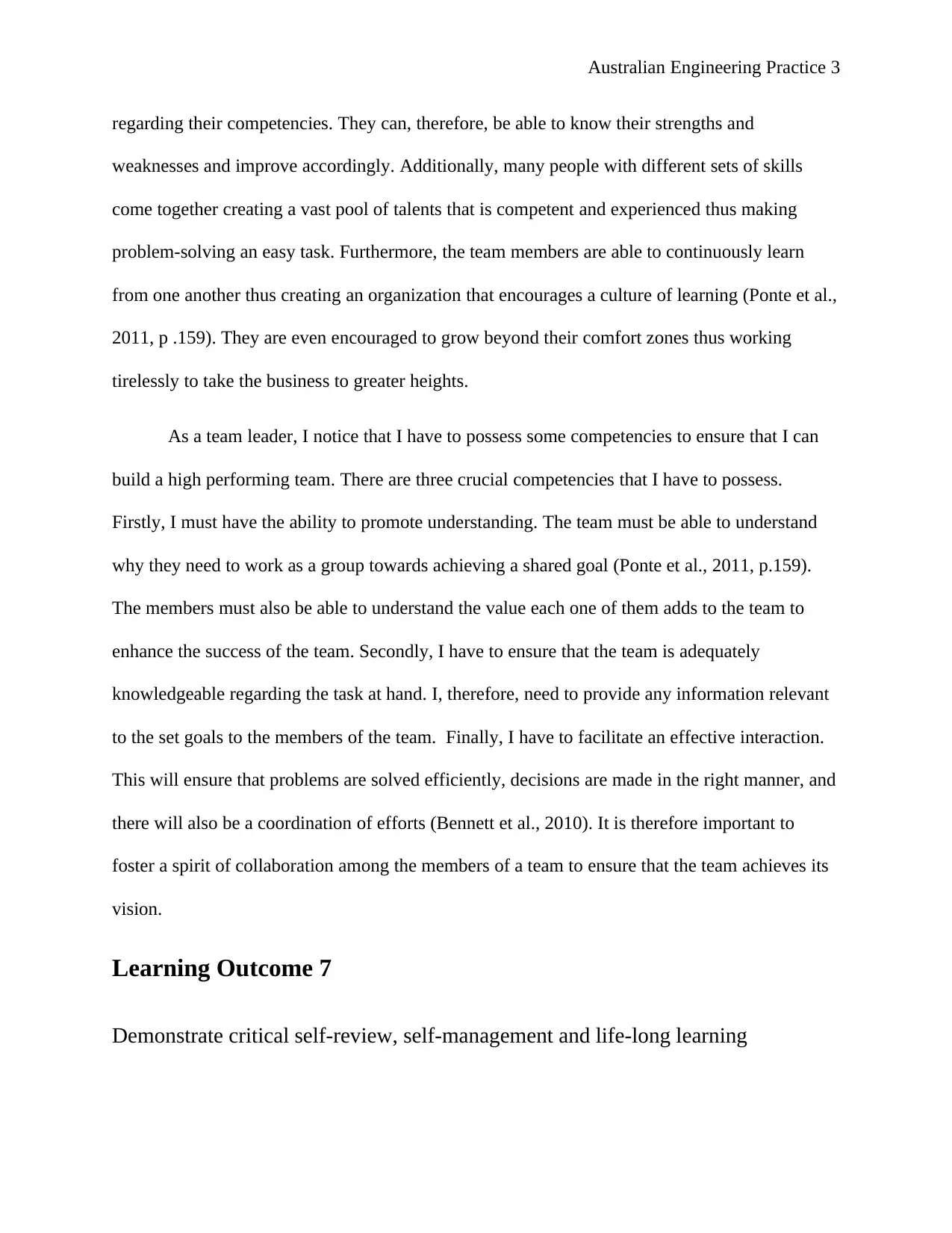
Australian Engineering Practice 3
regarding their competencies. They can, therefore, be able to know their strengths and
weaknesses and improve accordingly. Additionally, many people with different sets of skills
come together creating a vast pool of talents that is competent and experienced thus making
problem-solving an easy task. Furthermore, the team members are able to continuously learn
from one another thus creating an organization that encourages a culture of learning (Ponte et al.,
2011, p .159). They are even encouraged to grow beyond their comfort zones thus working
tirelessly to take the business to greater heights.
As a team leader, I notice that I have to possess some competencies to ensure that I can
build a high performing team. There are three crucial competencies that I have to possess.
Firstly, I must have the ability to promote understanding. The team must be able to understand
why they need to work as a group towards achieving a shared goal (Ponte et al., 2011, p.159).
The members must also be able to understand the value each one of them adds to the team to
enhance the success of the team. Secondly, I have to ensure that the team is adequately
knowledgeable regarding the task at hand. I, therefore, need to provide any information relevant
to the set goals to the members of the team. Finally, I have to facilitate an effective interaction.
This will ensure that problems are solved efficiently, decisions are made in the right manner, and
there will also be a coordination of efforts (Bennett et al., 2010). It is therefore important to
foster a spirit of collaboration among the members of a team to ensure that the team achieves its
vision.
Learning Outcome 7
Demonstrate critical self-review, self-management and life-long learning
regarding their competencies. They can, therefore, be able to know their strengths and
weaknesses and improve accordingly. Additionally, many people with different sets of skills
come together creating a vast pool of talents that is competent and experienced thus making
problem-solving an easy task. Furthermore, the team members are able to continuously learn
from one another thus creating an organization that encourages a culture of learning (Ponte et al.,
2011, p .159). They are even encouraged to grow beyond their comfort zones thus working
tirelessly to take the business to greater heights.
As a team leader, I notice that I have to possess some competencies to ensure that I can
build a high performing team. There are three crucial competencies that I have to possess.
Firstly, I must have the ability to promote understanding. The team must be able to understand
why they need to work as a group towards achieving a shared goal (Ponte et al., 2011, p.159).
The members must also be able to understand the value each one of them adds to the team to
enhance the success of the team. Secondly, I have to ensure that the team is adequately
knowledgeable regarding the task at hand. I, therefore, need to provide any information relevant
to the set goals to the members of the team. Finally, I have to facilitate an effective interaction.
This will ensure that problems are solved efficiently, decisions are made in the right manner, and
there will also be a coordination of efforts (Bennett et al., 2010). It is therefore important to
foster a spirit of collaboration among the members of a team to ensure that the team achieves its
vision.
Learning Outcome 7
Demonstrate critical self-review, self-management and life-long learning
⊘ This is a preview!⊘
Do you want full access?
Subscribe today to unlock all pages.

Trusted by 1+ million students worldwide
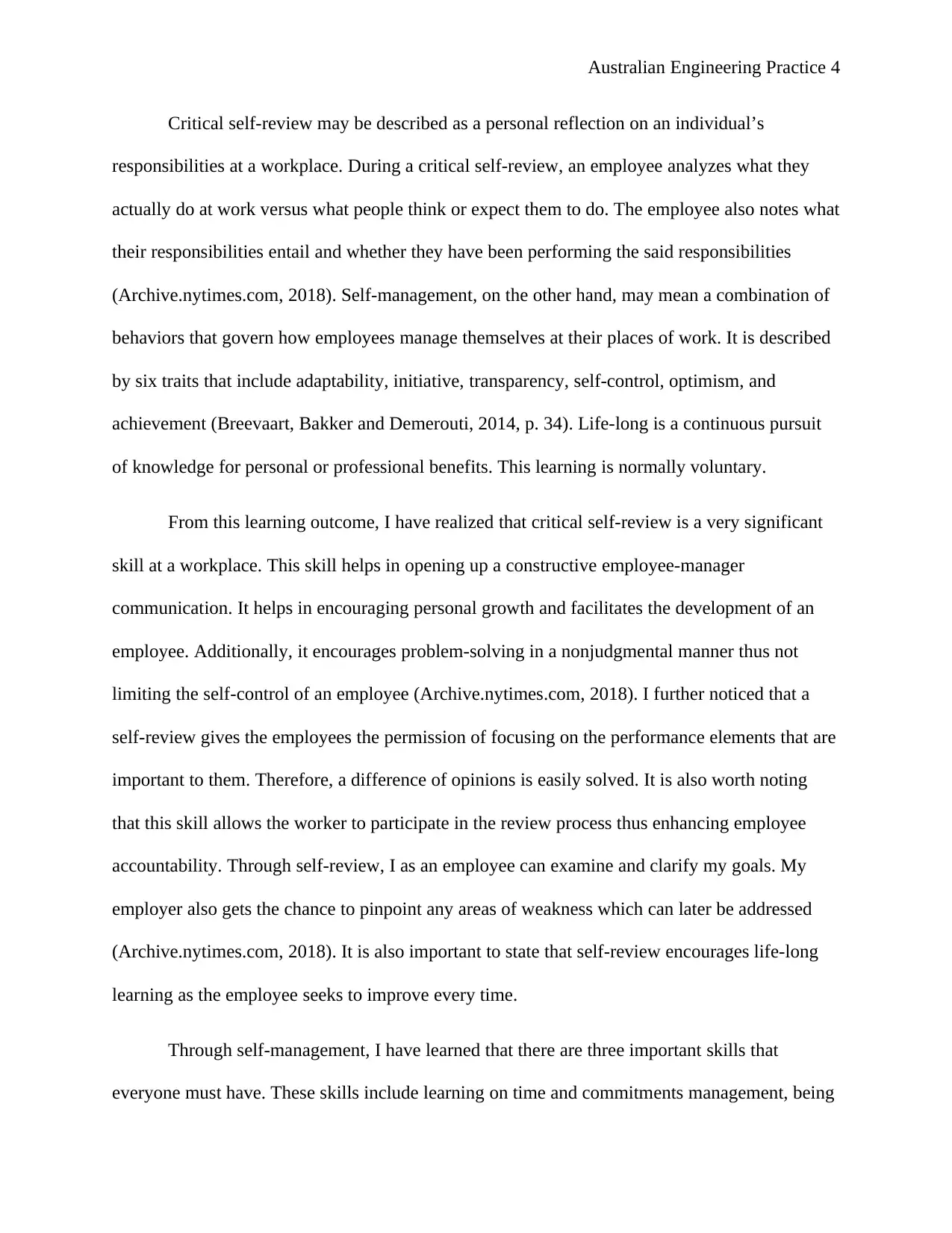
Australian Engineering Practice 4
Critical self-review may be described as a personal reflection on an individual’s
responsibilities at a workplace. During a critical self-review, an employee analyzes what they
actually do at work versus what people think or expect them to do. The employee also notes what
their responsibilities entail and whether they have been performing the said responsibilities
(Archive.nytimes.com, 2018). Self-management, on the other hand, may mean a combination of
behaviors that govern how employees manage themselves at their places of work. It is described
by six traits that include adaptability, initiative, transparency, self-control, optimism, and
achievement (Breevaart, Bakker and Demerouti, 2014, p. 34). Life-long is a continuous pursuit
of knowledge for personal or professional benefits. This learning is normally voluntary.
From this learning outcome, I have realized that critical self-review is a very significant
skill at a workplace. This skill helps in opening up a constructive employee-manager
communication. It helps in encouraging personal growth and facilitates the development of an
employee. Additionally, it encourages problem-solving in a nonjudgmental manner thus not
limiting the self-control of an employee (Archive.nytimes.com, 2018). I further noticed that a
self-review gives the employees the permission of focusing on the performance elements that are
important to them. Therefore, a difference of opinions is easily solved. It is also worth noting
that this skill allows the worker to participate in the review process thus enhancing employee
accountability. Through self-review, I as an employee can examine and clarify my goals. My
employer also gets the chance to pinpoint any areas of weakness which can later be addressed
(Archive.nytimes.com, 2018). It is also important to state that self-review encourages life-long
learning as the employee seeks to improve every time.
Through self-management, I have learned that there are three important skills that
everyone must have. These skills include learning on time and commitments management, being
Critical self-review may be described as a personal reflection on an individual’s
responsibilities at a workplace. During a critical self-review, an employee analyzes what they
actually do at work versus what people think or expect them to do. The employee also notes what
their responsibilities entail and whether they have been performing the said responsibilities
(Archive.nytimes.com, 2018). Self-management, on the other hand, may mean a combination of
behaviors that govern how employees manage themselves at their places of work. It is described
by six traits that include adaptability, initiative, transparency, self-control, optimism, and
achievement (Breevaart, Bakker and Demerouti, 2014, p. 34). Life-long is a continuous pursuit
of knowledge for personal or professional benefits. This learning is normally voluntary.
From this learning outcome, I have realized that critical self-review is a very significant
skill at a workplace. This skill helps in opening up a constructive employee-manager
communication. It helps in encouraging personal growth and facilitates the development of an
employee. Additionally, it encourages problem-solving in a nonjudgmental manner thus not
limiting the self-control of an employee (Archive.nytimes.com, 2018). I further noticed that a
self-review gives the employees the permission of focusing on the performance elements that are
important to them. Therefore, a difference of opinions is easily solved. It is also worth noting
that this skill allows the worker to participate in the review process thus enhancing employee
accountability. Through self-review, I as an employee can examine and clarify my goals. My
employer also gets the chance to pinpoint any areas of weakness which can later be addressed
(Archive.nytimes.com, 2018). It is also important to state that self-review encourages life-long
learning as the employee seeks to improve every time.
Through self-management, I have learned that there are three important skills that
everyone must have. These skills include learning on time and commitments management, being
Paraphrase This Document
Need a fresh take? Get an instant paraphrase of this document with our AI Paraphraser
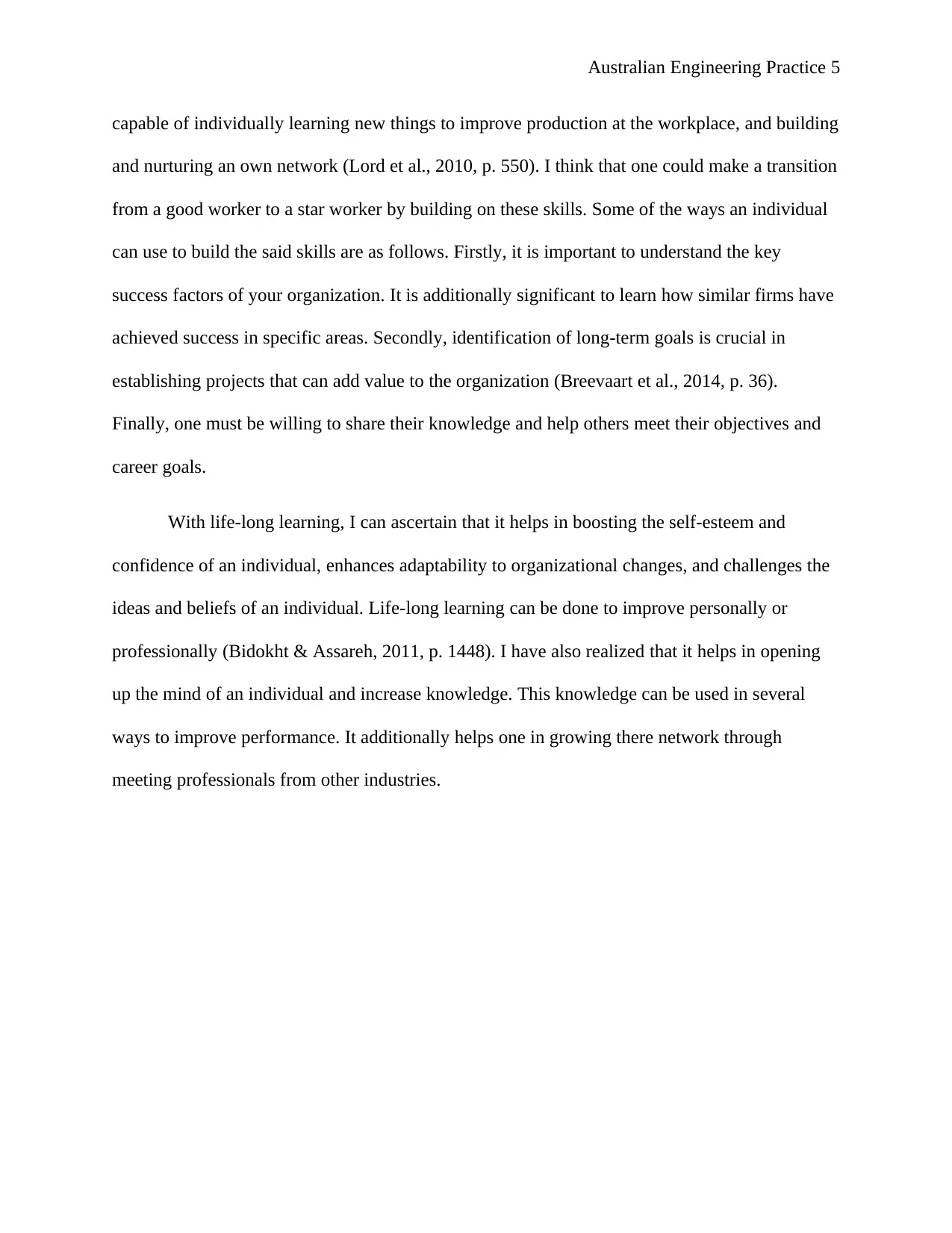
Australian Engineering Practice 5
capable of individually learning new things to improve production at the workplace, and building
and nurturing an own network (Lord et al., 2010, p. 550). I think that one could make a transition
from a good worker to a star worker by building on these skills. Some of the ways an individual
can use to build the said skills are as follows. Firstly, it is important to understand the key
success factors of your organization. It is additionally significant to learn how similar firms have
achieved success in specific areas. Secondly, identification of long-term goals is crucial in
establishing projects that can add value to the organization (Breevaart et al., 2014, p. 36).
Finally, one must be willing to share their knowledge and help others meet their objectives and
career goals.
With life-long learning, I can ascertain that it helps in boosting the self-esteem and
confidence of an individual, enhances adaptability to organizational changes, and challenges the
ideas and beliefs of an individual. Life-long learning can be done to improve personally or
professionally (Bidokht & Assareh, 2011, p. 1448). I have also realized that it helps in opening
up the mind of an individual and increase knowledge. This knowledge can be used in several
ways to improve performance. It additionally helps one in growing there network through
meeting professionals from other industries.
capable of individually learning new things to improve production at the workplace, and building
and nurturing an own network (Lord et al., 2010, p. 550). I think that one could make a transition
from a good worker to a star worker by building on these skills. Some of the ways an individual
can use to build the said skills are as follows. Firstly, it is important to understand the key
success factors of your organization. It is additionally significant to learn how similar firms have
achieved success in specific areas. Secondly, identification of long-term goals is crucial in
establishing projects that can add value to the organization (Breevaart et al., 2014, p. 36).
Finally, one must be willing to share their knowledge and help others meet their objectives and
career goals.
With life-long learning, I can ascertain that it helps in boosting the self-esteem and
confidence of an individual, enhances adaptability to organizational changes, and challenges the
ideas and beliefs of an individual. Life-long learning can be done to improve personally or
professionally (Bidokht & Assareh, 2011, p. 1448). I have also realized that it helps in opening
up the mind of an individual and increase knowledge. This knowledge can be used in several
ways to improve performance. It additionally helps one in growing there network through
meeting professionals from other industries.
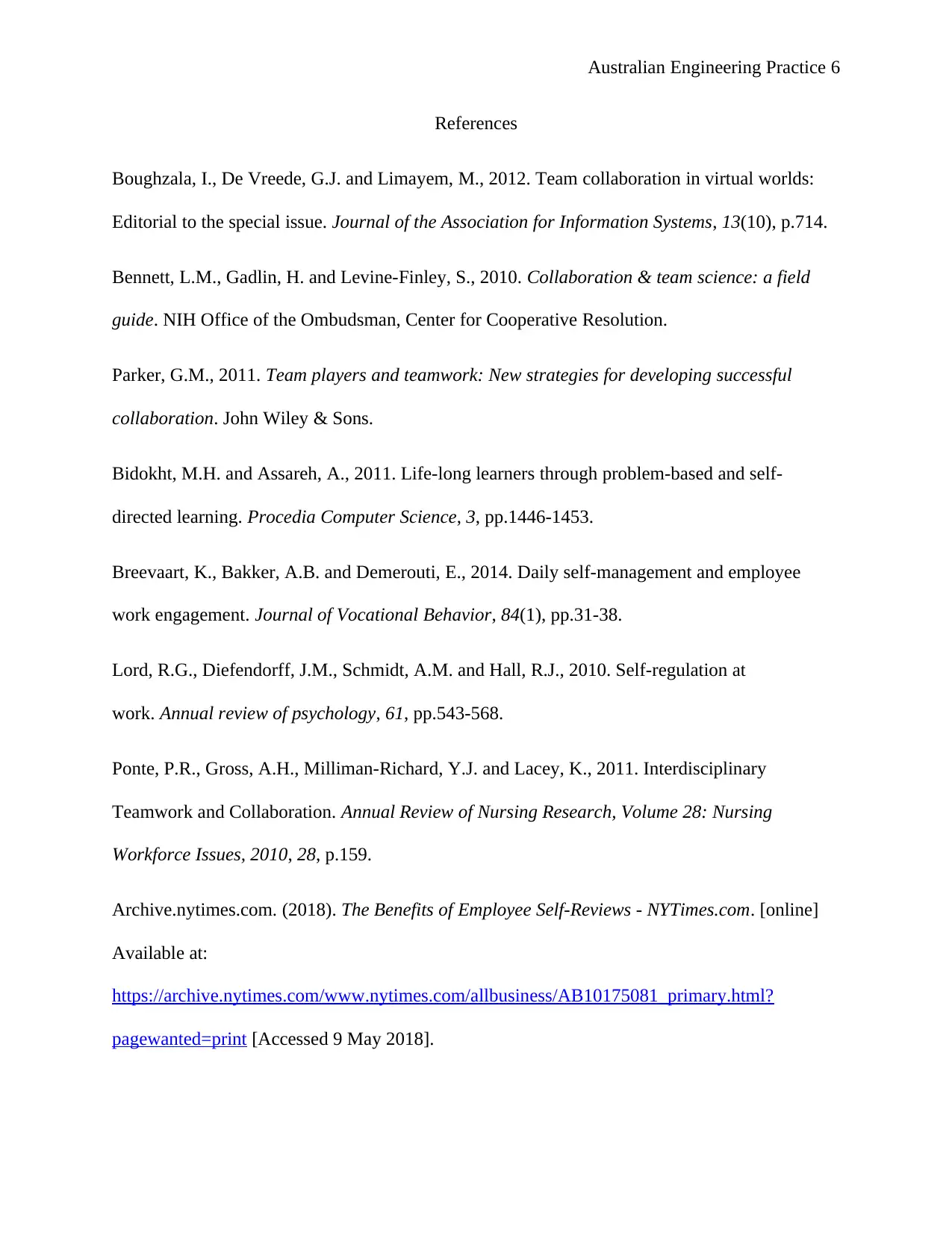
Australian Engineering Practice 6
References
Boughzala, I., De Vreede, G.J. and Limayem, M., 2012. Team collaboration in virtual worlds:
Editorial to the special issue. Journal of the Association for Information Systems, 13(10), p.714.
Bennett, L.M., Gadlin, H. and Levine-Finley, S., 2010. Collaboration & team science: a field
guide. NIH Office of the Ombudsman, Center for Cooperative Resolution.
Parker, G.M., 2011. Team players and teamwork: New strategies for developing successful
collaboration. John Wiley & Sons.
Bidokht, M.H. and Assareh, A., 2011. Life-long learners through problem-based and self-
directed learning. Procedia Computer Science, 3, pp.1446-1453.
Breevaart, K., Bakker, A.B. and Demerouti, E., 2014. Daily self-management and employee
work engagement. Journal of Vocational Behavior, 84(1), pp.31-38.
Lord, R.G., Diefendorff, J.M., Schmidt, A.M. and Hall, R.J., 2010. Self-regulation at
work. Annual review of psychology, 61, pp.543-568.
Ponte, P.R., Gross, A.H., Milliman-Richard, Y.J. and Lacey, K., 2011. Interdisciplinary
Teamwork and Collaboration. Annual Review of Nursing Research, Volume 28: Nursing
Workforce Issues, 2010, 28, p.159.
Archive.nytimes.com. (2018). The Benefits of Employee Self-Reviews - NYTimes.com. [online]
Available at:
https://archive.nytimes.com/www.nytimes.com/allbusiness/AB10175081_primary.html?
pagewanted=print [Accessed 9 May 2018].
References
Boughzala, I., De Vreede, G.J. and Limayem, M., 2012. Team collaboration in virtual worlds:
Editorial to the special issue. Journal of the Association for Information Systems, 13(10), p.714.
Bennett, L.M., Gadlin, H. and Levine-Finley, S., 2010. Collaboration & team science: a field
guide. NIH Office of the Ombudsman, Center for Cooperative Resolution.
Parker, G.M., 2011. Team players and teamwork: New strategies for developing successful
collaboration. John Wiley & Sons.
Bidokht, M.H. and Assareh, A., 2011. Life-long learners through problem-based and self-
directed learning. Procedia Computer Science, 3, pp.1446-1453.
Breevaart, K., Bakker, A.B. and Demerouti, E., 2014. Daily self-management and employee
work engagement. Journal of Vocational Behavior, 84(1), pp.31-38.
Lord, R.G., Diefendorff, J.M., Schmidt, A.M. and Hall, R.J., 2010. Self-regulation at
work. Annual review of psychology, 61, pp.543-568.
Ponte, P.R., Gross, A.H., Milliman-Richard, Y.J. and Lacey, K., 2011. Interdisciplinary
Teamwork and Collaboration. Annual Review of Nursing Research, Volume 28: Nursing
Workforce Issues, 2010, 28, p.159.
Archive.nytimes.com. (2018). The Benefits of Employee Self-Reviews - NYTimes.com. [online]
Available at:
https://archive.nytimes.com/www.nytimes.com/allbusiness/AB10175081_primary.html?
pagewanted=print [Accessed 9 May 2018].
⊘ This is a preview!⊘
Do you want full access?
Subscribe today to unlock all pages.

Trusted by 1+ million students worldwide
1 out of 6
Related Documents
Your All-in-One AI-Powered Toolkit for Academic Success.
+13062052269
info@desklib.com
Available 24*7 on WhatsApp / Email
![[object Object]](/_next/static/media/star-bottom.7253800d.svg)
Unlock your academic potential
Copyright © 2020–2025 A2Z Services. All Rights Reserved. Developed and managed by ZUCOL.





